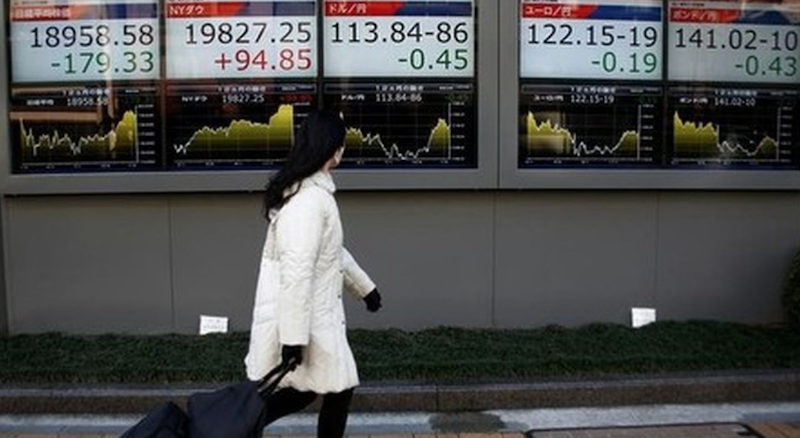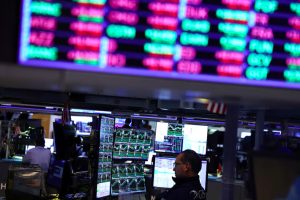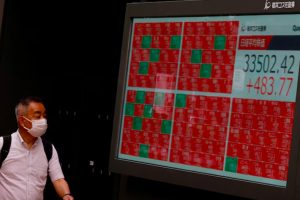Asia’s major stock indexes ended the year with contrasting fortunes on Friday as Japan’s Nikkei capped its best year in a decade while China’s markets saw a third year of declines.
The region’s investors took a breather on the last trading day of the year with Asia set to snap its two-year losing streak with the mood recently buoyed by expectations that the Federal Reserve will start cutting interest rates next year.
Tokyo’s Nikkei share average closed 2023 ahead 28%, its biggest yearly gain since 2013, the year Haruhiko Kuroda took his seat as the Governor of the Bank of Japan and began massive monetary easing to boost asset value.
Also on AF: Nvidia Launches Modified Gaming Chip For Chinese Market
On Friday, the Nikkei was down 0.22%, or 75.45 points, to close at 33,464.17, while the broader Topix was ahead 0.19%, or 4.37 points, to 2,366.39, putting it 25% ahead for the year.
The Nikkei was also the best performing index in Asia, underpinned by the yen’s 7% annual loss against the dollar.
The yen, however rose 5% against the dollar this month, which prevented the Nikkei from hitting a new milestone, market players said.
China and Hong Kong stocks were set for their best week in five months, but will end 2023 with yearly losses exceeding 10% as the world’s worst-performing major equity markets.
China’s blue chip CSI300 Index is registering an unprecedented, third straight year of declines amid the country’s slow post-Covid recovery and intermittent geopolitical tensions, but some see opportunities in its battered shares.
China “disappointed investors who expected a strong recovery” post-Covid, William Witherell, chief global economist at Cumberland Advisors said in a note. “The economy was hit with widespread and persistent housing and local government debt problems, the clean-up of which continues.”
On Friday, the CSI300 rose 0.49% and was poised to climb roughly 2.4% for the week, while the Shanghai Composite Index rose 0.68%, or 20.23 points, to 2,974.93. The Shenzhen Composite Index on China’s second exchange gained 1.13%, or 20.47 points, to 1,837.85.
Hong Kong’s Hang Seng Index edged up 0.02%, or 3.86 points, to 17,047.39 and was on track for a 4% weekly gain.
MSCI’s broadest index of Asia-Pacific shares outside Japan was little changed on Friday but lurked near a five-month peak and was headed for a 5% gain in the year after two years of heavy losses.
In Asia, the best performing major stock market in 2023 apart from Japan’s Nikkei was Taiwan’s with a 26.6% rise in the year. India’s Nifty was the third best gainer with a 20% rise in 2023.
Thailand’s SET index on the other hand was the worst performing stock market in Asia this year with a decline of 15%.
US Dollar On Back Foot
In contrast, the MSCI world equity index was set to end 2023 up around 20%, with stellar gains recorded in markets including the United States, India and Mexico.
Futures indicate European bourses are likely to have a subdued end to the year as traders consolidate their positions.
The pan-European STOXX 600 has had a blistering end to the year and is up 11% in the past two months and is hovering around its 23-month peak.
Overnight, the S&P 500 ended Thursday’s session just 0.3% shy of its record closing high, reached on January 3, 2022.
The global bonds rally has continued, leading yields lower, after being battered for the most part of the past two years as interest rates rose. The 10-year US Treasury yield was at 3.8387%, having briefly touched 3.820%, its lowest since July 19 on Thursday.
In the currency market, the dollar was rooted on the back foot and headed for a 2% decline this year after two years of strong gains, driven by first the anticipation of and then the actual hiking of rates by the Fed to battle inflation.
Against a basket of currencies, the dollar was last at 101.50, edging away from the five-month low of 100.61 it touched on Wednesday.
Oil prices were due to end the year 10% lower as geopolitical concerns, production cuts and global measures to rein in inflation triggered wild fluctuations in prices. US crude rose 0.24% to $71.94 per barrel and Brent was at $77.41, up 0.34%.
Gold prices rose and were poised to end their best year in three. Spot gold added 0.2% to $2,068.86 an ounce.
Key figures
Tokyo – Nikkei 225 < DOWN 0.22% at 33,464.17 (close)
Hong Kong – Hang Seng Index > UP 0.02% at 17,047.39 (close)
Shanghai – Composite > UP 0.68% at 2,974.93 (close)
London – FTSE 100 > UP 0.29% at 7,745.52 (0934 GMT)
New York – Dow > UP 0.14% at 37,710.10 (Thursday close)
- Reuters with additional editing by Sean O’Meara
Read more:
Cargo Rates Soar as Firms Assess Bid to Protect Red Sea Ships
China Told to Expect More Heatwaves, Extreme Weather in 2024
Hang Seng Surges on Fed Bets, Sell-Off Sparks Nikkei Slide
Nikkei, Hang Seng Surge Amid Global Rally on Rate Cut Optimism
























